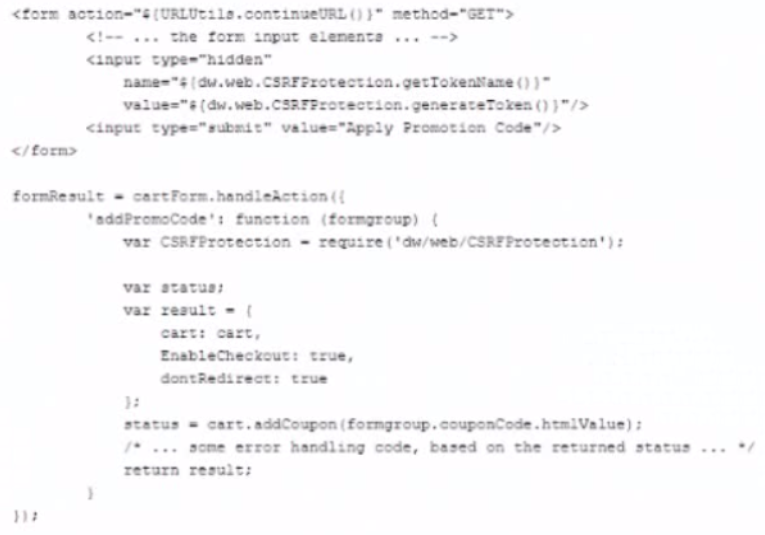Curious about Actual Salesforce Certified B2C Commerce Architect Exam Questions?
Here are sample Salesforce Certified B2C Commerce Architect (B2C Commerce Architect) Exam questions from real exam. You can get more Salesforce Architect (B2C Commerce Architect) Exam premium practice questions at TestInsights.
a clientuses an external marketing toot to manage promotions and coupons for its multiple brands. They currently have only one brand on B2C Commerce and thev get Import-ready feeds created by this tool on en SFTP location.
The marketing team completes the data preparation by the end of the work day.
How should the Architect handle this import?
Correct : C
To handle the import of promotion and coupon data from an SFTP location, the best approach is to create a job consisting of three steps as described in option C. The first step involves a custom script to download the files from the SFTP server---this is necessary because file retrieval from external servers typically requires specific connectivity and security configurations that are best handled in a custom-coded step. The subsequent two steps would utilize standard Salesforce B2C Commerce job steps to import the downloaded promotion and coupon data into the platform. This method ensures that the data flow is streamlined, from retrieval through to integration into the Commerce platform.
Start a Discussions
During the testing of the login form, QA finds out that the first time the user can log in, but every other login attempt from another computer leads to the homepage and the basket being emptied. Developers tried to debug the issue, but when they add a breakpoint to the login action, it is not hit by the debugger.
Whatshould the Architect recommend developers to check?
Correct : D
When QA encounters issues with login persistence across multiple computers, where subsequent logins lead to a redirection and an emptied basket, the likely culprit could be unintended caching of login-related pages or processes. In Salesforce B2C Commerce, certain cache settings might inadvertently cause user sessions to be shared or not properly invalidated. The recommendation D, to check the login form and related templates for caching directives that might be erroneously caching login actions or user-specific data, addresses this potential issue. Developers should ensure that pages handling user sessions and authentication are configured to disable caching, thus preventing session data from being mistakenly retained or shared across different users.
Start a Discussions
A Client has automated builds that deploy the code; however, recent builds started failing with compilation issues, which are not reproducible in developer's environment.
Whetfirst step needs to be taken to identify and fix the issue?
Correct : A
When facing build failures that are not reproducible in developers' environments, a common and effective first step is to clean up the build server workspace (Answer A). This action clears any residual files, settings, or data that might be influencing the build process and causing discrepancies between local and server builds. By resetting the workspace to a clean state, it helps ensure that the build process is starting from a consistent base, potentially resolving issues caused by stale data or corrupted build artifacts. This step often resolves hidden configuration or environment-specific issues that are not immediately apparent in the code or module versions.
Start a Discussions
A B2C Commerce Developer has just finished implementing a new promotion code form on checkout. During review, an Architect notes that the form it not using CSRF validation correctly.

Which two options are best practice recommendations for dealing with CSRF validation? Choose 2 answers
Correct : A, D
For implementing CSRF (Cross-Site Request Forgery) protection correctly, especially in forms like promotion code submissions during checkout, best practices include:
Option A (Ensure the CSRF protection is validated on form submission): It is crucial to validate the CSRF token upon the form's submission to ensure that the request originates from a legitimate source and corresponds to the user's intended actions, enhancing security against CSRF attacks.
Option D (Only use POST methods over HTTPS): Using POST methods for transmitting form data helps mitigate the risk of CSRF attacks as opposed to GET methods which can be manipulated more easily via URL. Ensuring the communication is over HTTPS encrypts the transmission, securing the data from interception or tampering during transit.
These practices safeguard against common security vulnerabilities and ensure that the application adheres to secure coding standards.
Start a Discussions
A developer is validating the pipeline cache and noticed that the PDP page is very low cached. The one parameter is snowing the position on the product fisting page upon checking the site and code.
What should the developer adjust in order to improve the page cache hit ratio, keeping in mind that the client is Insisting on the parameter for their analytics?
Correct : B
Start a Discussions
Total 64 questions